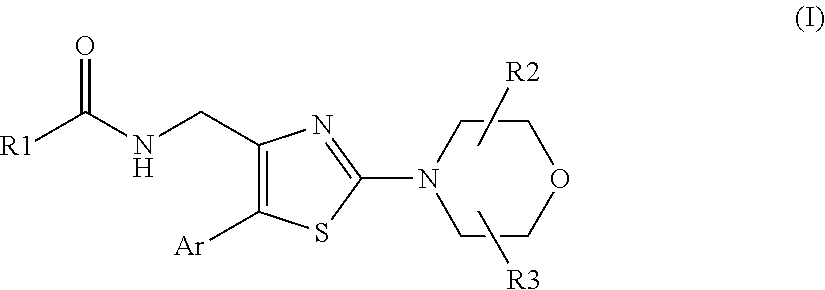Morpholinothiazoles as alpha 7 positive allosteric modulators
a technology of allosteric modulators and morpholinothiazoles, which is applied in the field of positive allosteric modulators of nicotinic acetylcholine receptors, can solve the problems of chronic administration of ach agonists, difficult treatment of nicotinic receptor agonists acting at the same site as ach,
- Summary
- Abstract
- Description
- Claims
- Application Information
AI Technical Summary
Benefits of technology
Problems solved by technology
Method used
Image
Examples
example 1
B1) Example 1
N-[[2-[(2R,6S)-2,6-dimethyl-4-morpholinyl]-5-(2,6-dimethyl-4-pyridinyl)-4-thiazolyl]methyl]-cyclopropaneacetamide (Compound 1)
[0186]
[0187]A mixture of cyclopropylacetic acid (5 g, 49.94 mmol), HBTU (19.16 g, 50.53 mmol) and DIPEA (15.31 mL, 92.64 mmol) in 250 ml dichloromethane was stirred for 15 min at room temperature. Intermediate 5 (14 g, 42.11 mmol) in 80 ml dichloromethane was added dropwise and stirring was continued for 2 hours at room temperature.
[0188]The reaction mixture was treated with 1N NaOH and the organic layer was washed three times with water. The organic layer was separated, dried with MgSO4 and concentrated under reduced pressure.
[0189]This residue was purified on a silica column with an eluent gradient from 100% DCM to 98 / 2 DCM / MeOH. The corresponding pure fractions were collected and evaporated. The product was treated with Et2O, filtered and dried in vacuum, yielding 11.8 g (68%) of Compound 1.
example 2
B2) Example 2
N-[[2-[(2R,6S)-2,6-dimethyl-4-morpholinyl]-5-(2,6-dimethyl-4-pyridinyl)-4-thiazolyl]methyl]-3-methyl-5-isoxazolecarboxamide (Compound 4)
[0190]
[0191]DIPEA (0.16 mL, 0.97 mmol) was added to a solution of Intermediate 5 (150 mg, 0.45 mmol) in DCM (6 mL). The reaction mixture was cooled to 0° C. under nitrogen atmosphere. 3-Methylisoxazole-5-carbonyl chloride (79 mg, 0.54 mmol) was then added dropwise and stirring was continued for 1 h at room temperature. The reaction was washed with sodium bicarbonate and then twice with water. The organic layer was dried over a magnesium sulphate plug and evaporated. The residue was purified by preparative HPLC (RP Shandon Hyperprep C18 BDS—8 μm, 250 g, 5 cm; mobile phase (0.25% NH4HCO3 solution in water, CH3CN)), yielding 127 mg (64%) of Compound 4.
example 3
B3) Example 3
N-[[2-[(2R,6S)-2,6-dimethyl-4-morpholinyl]-5-(2,6-dimethyl-4-pyridinyl)-4-thiazolyl]methyl]-acetamide (Compound 60)
[0192]
[0193]A mixture of Intermediate 5 (150 mg, 0.45 mmol) and triethylamine (0.063 mL, 0.54 mmol) was stirred in dichloromethane (6 mL) at room temperature. Acetic acid anhydride (0.051 mL, 0.54 mmol) was added and the reaction mixture was stirred at room temperature for 2 h. The reaction mixture was washed with a potassium carbonate solution. The organic layer was dried on MgSO4, filtered, and evaporated. The residue was purified by preparative HPLC (RP Shandon Hyperprep C18 BDS—8 μm, 250 g, 5 cm; mobile phase (0.25% NH4HCO3 solution in water, MeOH+CH3CN)), yielding 100 mg (59%) of Compound 60.
PUM
| Property | Measurement | Unit |
|---|---|---|
| pharmaceutical composition | aaaaa | aaaaa |
| conformational state | aaaaa | aaaaa |
| pharmaceutical compositions | aaaaa | aaaaa |
Abstract
Description
Claims
Application Information
 Login to View More
Login to View More - R&D
- Intellectual Property
- Life Sciences
- Materials
- Tech Scout
- Unparalleled Data Quality
- Higher Quality Content
- 60% Fewer Hallucinations
Browse by: Latest US Patents, China's latest patents, Technical Efficacy Thesaurus, Application Domain, Technology Topic, Popular Technical Reports.
© 2025 PatSnap. All rights reserved.Legal|Privacy policy|Modern Slavery Act Transparency Statement|Sitemap|About US| Contact US: help@patsnap.com



